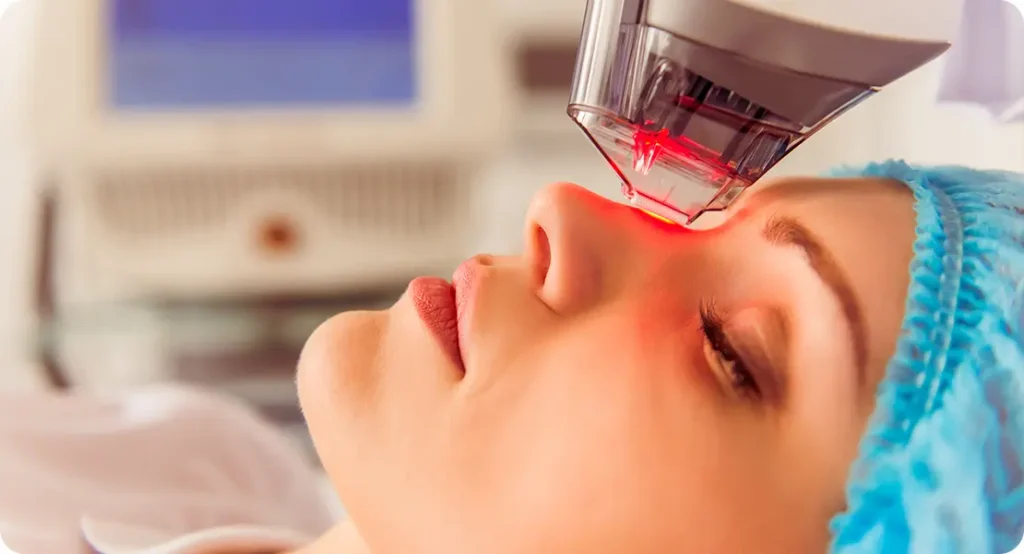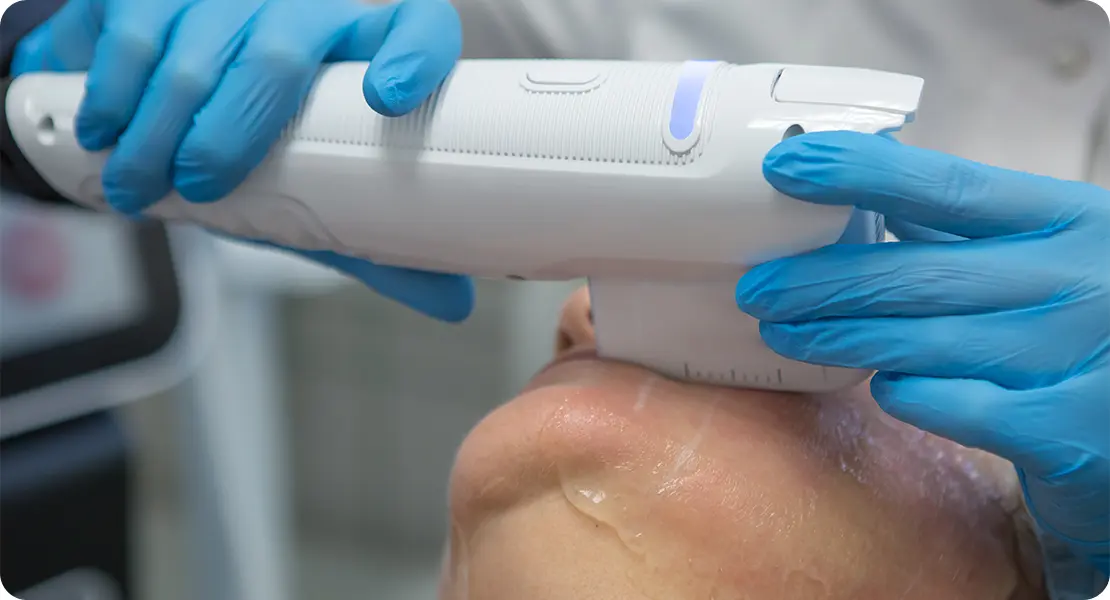Fraxel laser treatment is a versatile tool in modern dermatology, offering benefits like improved skin texture, reduced pigmentation, fine line reduction, and rejuvenation. Many people often wonder, “What is the best age to start Fraxel?”
Unlike some procedures that are strictly age-dependent, Fraxel’s timing is more about your skin condition, lifestyle, and individual ageing signs. In this guide, I’ll explain how dermatologists determine the ideal time to begin Fraxel treatments, what signs to look for, and how starting at the right time can enhance results.
By the end, you’ll understand why age alone isn’t the only factor and how you can decide when Fraxel is right for you.
How Fraxel Works
Fraxel is a type of fractional laser that works by creating tiny, controlled columns in your skin. These microscopic treatment zones trigger your body’s natural repair processes, encouraging collagen production and skin renewal.
Here’s what this means for you:
- Reduce fine lines and wrinkles – You’ll notice smoother skin as Fraxel helps fill in those early signs of aging.
- Improve skin texture and tone – Rough patches, uneven tone, and dullness can gradually fade, giving your skin a healthier, more even appearance.
- Fade sun spots, pigmentation, and acne scars – Whether it’s damage from the sun or old blemishes, Fraxel can help reduce visible marks over time.
- Tighten and rejuvenate skin gradually – Instead of drastic changes overnight, you’ll see a natural lift and firmness as your skin rebuilds itself.
Because Fraxel stimulates your skin’s own healing mechanisms, it’s versatile enough for a wide range of skin types and concerns. This means it’s not just about your age it’s about the current condition of your skin and what you want to improve.
With multiple sessions, you can expect gradual, natural-looking results that enhance your skin’s overall health and glow, making it an option you can customise depending on your goals.
Why Age Isn’t the Only Factor

You might think Fraxel is just for people in their 40s or 50s, but that’s not the case. Age is only one part of the picture. Dermatologists consider several other factors to determine the right time for you to start treatment:
Your Skin Condition
Even if your skin looks healthy and youthful, you can benefit from preventive Fraxel treatments to maintain smooth texture and an even tone. If you’re already noticing early sun damage, pigmentation, or fine lines, starting earlier can help slow down further changes. Fraxel is also effective for treating acne scars or other imperfections, which means even younger adults can see results.
Your Lifestyle
If you spend a lot of time in the sun, live in a polluted city, or smoke, your skin can age faster. Fraxel can help repair some of this environmental damage, so if your lifestyle exposes your skin to these factors, you might want to consider starting treatments sooner rather than later.
Your Personal Ageing Signs
Signs like crow’s feet, smile lines, or early sagging can start appearing in your late 20s or early 30s. If you notice these changes, dermatologists may recommend Fraxel to prevent deeper lines from forming and keep your skin looking youthful.
In short, the timing for Fraxel isn’t about hitting a certain age it’s about what your skin needs right now. Your dermatologist will tailor the treatment plan specifically for you, helping you achieve smoother, healthier-looking skin at any stage of life.
Recommended Age Ranges
Fraxel isn’t limited to a specific age it can be tailored to suit your skin no matter when you start. Here’s a helpful guide to what you can expect at different stages:
1. Your 20s to Early 30s: Preventive Care and Mild Concerns
- Purpose: At this stage, Fraxel can help maintain your youthful skin while addressing minor pigmentation, acne scars, or uneven tone.
- Benefits: You’ll help prevent early signs of ageing and keep your skin smooth, bright, and even.
- Sessions: Most people in this age group need fewer treatments compared to older adults sometimes just one or two sessions are enough to maintain results.
2. Mid-30s to Early 40s: Early Ageing Signs
- Purpose: This is when fine lines, early wrinkles, sun spots, and uneven skin tone may start appearing. Fraxel can help tackle these issues before they get deeper.
- Benefits: You’ll slow down visible ageing, refresh your skin, and boost radiance for a more youthful appearance.
- Sessions: Typically, 2–3 sessions spaced a few weeks apart give the best results, though your dermatologist will customise this for you.
3. 40s and Beyond: Advanced Ageing or Sun Damage
- Purpose: At this stage, Fraxel is often used to address deeper wrinkles, sun damage, pigmentation, and texture irregularities.
- Benefits: You’ll notice an overall improvement in skin tone, firmness, and smoothness, thanks to enhanced collagen production.
- Sessions: Depending on your skin condition, 3–4 treatments are usually recommended for the most noticeable results.
No matter your age, Fraxel is flexible enough to be adjusted to your skin’s needs, helping you achieve smoother, healthier-looking skin at every stage of life.
Why Early Treatment Can Be Beneficial

You don’t have to wait until deep wrinkles or sun damage appear to start thinking about Fraxel. Starting treatments early can give your skin a real advantage:
- Prevention: By maintaining your skin’s collagen and texture now, you can reduce the need for more intensive treatments later. Essentially, you’re keeping your skin in top shape before bigger issues appear.
- Gradual Improvement: Early intervention allows you to enjoy subtle, natural-looking changes over time. Instead of dramatic results all at once, your skin improves gradually, keeping your look fresh and youthful.
- Reduced Downtime: Younger skin typically heals faster, which means you’ll recover more quickly between sessions and experience less redness or peeling.
Preventive Fraxel is especially popular if you have fair skin or a history of sun exposure. By tackling cumulative damage early, you’re helping your skin stay healthy, radiant, and resilient for years to come.
How Dermatologists Personalise Fraxel Timing
Your skin is unique, and a one-size-fits-all approach doesn’t work with Fraxel. Dermatologists carefully personalise the timing and treatment plan to suit you, using several key factors:
Skin Assessment: They’ll look closely at your wrinkles, pigmentation, texture, and elasticity to understand exactly what your skin needs.
Lifestyle Analysis: Your daily habits matter. Sun exposure, skincare routines, and environmental factors all play a role in determining the right time for Fraxel.
Your Goals: Whether you want to prevent early signs of ageing, refresh your skin, or repair damage, your dermatologist will tailor the plan to help you achieve the results you’re looking for.
Medical History: Conditions like acne, rosacea, or previous procedures can influence the timing and intensity of treatment, so your dermatologist takes these into account.
By combining these assessments, your dermatologist ensures Fraxel is both safe and effective for you, giving you the best possible results while minimising risks. It’s all about creating a plan that fits your skin, lifestyle, and goals.
Recovery and Downtime Considerations
Your recovery after Fraxel depends on a few factors, including your age, skin type, and how deep your treatment goes. Here’s what you can typically expect:
Mild Treatments: If your session is on the gentler side, you might notice redness and slight flaking for 2–5 days. You can usually resume most of your normal activities quickly.
Deeper Treatments: For more intensive sessions, redness, swelling, and peeling can last up to 7–10 days. Your skin will gradually heal, revealing smoother, rejuvenated skin underneath.
To get the best results, it’s important to follow your dermatologist’s aftercare instructions. This usually includes protecting your skin from the sun, keeping it moisturised, and using recommended skincare products. By taking care of your skin during recovery, you’ll help ensure long-lasting, healthy results.
Combining Fraxel with Other Treatments
Fraxel works wonders on its own, but when paired with other treatments, it can deliver even more impressive results. The key is a personalised plan that suits your skin, lifestyle, and goals. Here’s how different treatments can complement Fraxel:
Chemical Peels: These help remove dead skin cells, smooth your texture, and reduce pigmentation. When combined with Fraxel, you get enhanced resurfacing, making your skin appear brighter and more even.
Microneedling: This treatment stimulates collagen production and is particularly effective for acne scars or deeper textural issues. Using microneedling alongside Fraxel can accelerate collagen renewal, giving your skin a firmer, more youthful look.
Injectables: Dermal fillers and Botox target volume loss and dynamic wrinkles that Fraxel alone can’t fully address. Together, these treatments provide a comprehensive rejuvenation, smoothing lines while improving skin tone and texture.
Topical Skincare: Daily care is crucial for maintaining your results. Ingredients like retinoids and antioxidants help your skin repair and renew itself, while SPF protects against future sun damage. Following a dermatologist-recommended skincare routine ensures your Fraxel results last longer and your skin stays healthy.
Lifestyle Considerations: Staying hydrated, eating a balanced diet, and avoiding excessive sun exposure can also enhance your outcomes. When you pair professional treatments with good habits, you give your skin the best chance to look its healthiest.
By combining treatments strategically, your dermatologist can create a customised plan that addresses multiple concerns at once. This means you’ll see more comprehensive, long-lasting improvements helping your skin look smoother, brighter, and more youthful over time.
Signs You Might Be Ready for Fraxel
You don’t need to wait for a certain age to start thinking about Fraxel. You might be ready sooner than you think if you notice any of the following:
Uneven Skin Tone or Texture: If your skin looks rough, dull, or uneven, Fraxel can help smooth it out and restore a more balanced appearance.
Early Fine Lines Around the Eyes or Mouth: Those first signs of ageing can be subtle, but early treatment can prevent them from becoming deeper over time.
Sunspots or Hyperpigmentation: Sun damage can show up even in your 20s or 30s. Fraxel helps fade these spots, giving your skin a clearer, more even tone.
Acne Scars or Surface Irregularities: If you’ve struggled with acne or minor skin imperfections, Fraxel can reduce scarring and improve overall skin texture.
Desire for Preventative Rejuvenation: Even if your skin looks healthy, you might want to take a proactive approach to maintain youthful, radiant skin.
If any of these apply to you, your dermatologist can assess your skin and recommend a personalised treatment plan. This ensures that Fraxel is timed perfectly for your needs, giving you the best results with minimal downtime.
Tips for Maintaining Your Fraxel Results
You’ve invested in your skin with Fraxel, and keeping those results lasts longer is all about a few key habits:
- Protect Your Skin from the Sun: Daily sunscreen is essential. Broad-spectrum SPF shields your skin from UV damage, helping maintain your smoother, brighter complexion.
- Follow a Consistent Skincare Routine: Moisturisers, antioxidants, and gentle exfoliation help your skin stay healthy and support the collagen renewal that Fraxel stimulates.
- Avoid Smoking: Smoking accelerates ageing and can reduce the effectiveness of collagen, so steering clear helps your skin stay youthful for longer.
- Regular Touch-Ups: Your dermatologist might recommend occasional Fraxel sessions to maintain your results. These follow-ups help keep your skin looking refreshed and prevent new damage from taking hold.
- Healthy Lifestyle Choices: Staying hydrated, eating a balanced diet, and getting enough sleep all contribute to glowing, resilient skin that maximises the benefits of your Fraxel treatment.
By adopting these habits, you can enjoy smoother, healthier-looking skin for years to come, making the most of your Fraxel investment.
FAQs about Fraxel laser treatment:
1. What is Fraxel and how does it work?
Fraxel is a fractional laser treatment designed to stimulate your skin’s natural healing processes. It works by creating tiny, controlled columns in your skin, which encourages collagen production and cellular renewal. Over time, you’ll notice improvements in skin texture, tone, and overall radiance. It can also fade sunspots, pigmentation, fine lines, and acne scars. The key advantage is that it encourages your own skin to repair itself, making the results appear natural and gradual.
2. At what age should I start Fraxel?
There isn’t a strict age for starting Fraxel. While many people associate it with middle-aged adults, what really matters is your skin’s condition, lifestyle, and early signs of ageing. If you notice fine lines, uneven texture, sunspots, or minor scarring in your 20s or 30s, you could benefit from preventive or corrective treatments. Dermatologists customise the timing based on your unique skin concerns rather than simply your chronological age.
3. How many Fraxel sessions will I need?
The number of sessions depends on your skin’s condition, age, and the concerns you want to address. Younger adults with mild concerns may only need one or two sessions to maintain results. Those with early signs of ageing might require two to three sessions spaced a few weeks apart, while deeper wrinkles, significant sun damage, or pigmentation issues in older adults typically need three to four sessions for optimal results. Your dermatologist will guide you based on a thorough assessment.
4. Does Fraxel hurt?
Most people describe the sensation during Fraxel treatment as a mild stinging or prickling feeling, similar to tiny pinches on the skin. Your dermatologist can apply a topical numbing cream to make the procedure more comfortable. After the session, you may feel warmth or mild tenderness for a few hours, but this usually resolves quickly. The discomfort is generally well-tolerated, especially considering the long-term benefits.
5. How long does recovery take?
Recovery varies depending on the depth of your treatment. With mild sessions, you may experience redness and slight flaking for two to five days, while deeper treatments can cause redness, swelling, and peeling for up to seven to ten days. During this time, it’s important to follow your dermatologist’s aftercare instructions, including using sunscreen, moisturisers, and gentle skincare products. Proper care ensures optimal healing and long-lasting results.
6. Can Fraxel treat acne scars?
Yes, Fraxel is effective for treating acne scars and other surface irregularities. By stimulating collagen production, it helps smooth the skin’s texture and reduce the visibility of scars over multiple sessions. Early intervention can make the results even more noticeable, especially if you combine Fraxel with other treatments like microneedling or chemical peels, under your dermatologist’s guidance.
7. Can I combine Fraxel with other treatments?
Absolutely. Fraxel can complement treatments such as chemical peels, microneedling, dermal fillers, or Botox. Combining these options allows you to address multiple concerns at once, from texture and pigmentation to volume loss and dynamic wrinkles. Topical skincare routines with antioxidants, retinoids, and SPF further support and maintain the results. A personalised plan ensures that the combination is safe and effective for your skin type and goals.
8. Is Fraxel suitable for all skin types?
Fraxel is versatile and can be adapted to a wide range of skin types and tones, though your dermatologist will evaluate your skin carefully before recommending treatment. Factors like sensitivity, pigmentation tendencies, or existing conditions such as rosacea or active acne may affect how the treatment is customised. A thorough assessment ensures that Fraxel is both safe and effective for your specific needs.
9. How long until I see results?
Results from Fraxel appear gradually because the treatment stimulates your skin’s natural repair processes. You may notice subtle improvements within a week, but the most visible changes generally develop over several weeks as collagen production increases. For optimal outcomes, multiple sessions may be recommended, and combining Fraxel with a good skincare routine and healthy lifestyle habits can enhance and prolong your results.
10. How can I maintain Fraxel results?
Maintaining your Fraxel results is about ongoing care. Daily sun protection with broad-spectrum SPF is essential to prevent new damage. Following a consistent skincare routine with moisturisers, antioxidants, and gentle exfoliation supports collagen renewal. Avoiding smoking and leading a healthy lifestyle also helps your skin stay youthful. Additionally, periodic touch-up sessions recommended by your dermatologist can keep your skin looking smooth, radiant, and refreshed over the long term.
Final Thoughts: Timing Your Fraxel Treatment
There is no universal “best age” for Fraxel. The ideal time depends on your skin condition, lifestyle, and personal ageing signs, rather than a specific number on the calendar.
Whether you’re seeking preventive care in your 20s, early rejuvenation in your 30s, or repair of sun damage and wrinkles in your 40s or beyond, Fraxel can be customised to meet your goals. If you’re considering Fraxel laser treatment in London, you can contact us at London Dermatology Centre to arrange a personalised treatment plan with our expert team.
References:
1. Bass, L. S., 2005. Rejuvenation of the aging face using Fraxel laser treatment. Aesthetic Surgery Journal, 25(3), pp.307-309. https://academic.oup.com/asj/article-abstract/25/3/307/228307
2. Tanzi, E. L. and Alster, T. S. (2008) “Fraxel laser indications and long-term follow-up.” Aesthetic Surgery Journal, 28(6), pp. 675–679. https://pubmed.ncbi.nlm.nih.gov/19083597/
3. Goel, A., Krupashankar, D. S., Aurangabadkar, S., Nischal, K. C., Omprakash, H. M. & Mysore, V., 2011. Fractional lasers in dermatology – current status and recommendations. Indian Journal of Dermatology, Venereology and Leprology, 77(4), pp.369-379. https://ijdvl.com/fractional-lasers-in-dermatology-current-status-and-recommendations/
4. Journal of Cutaneous and Aesthetic Surgery, 2023. Fractional laser resurfacing for acne scars: our experience. Journal of Cutaneous and Aesthetic Surgery, 16(1), pp.xxx-xxx. (Patients aged 19-45, mean ~28.5 yrs) https://journals.lww.com/jcas/Fulltext/2023/16010/Fractional_laser_resurfacing_for_acne_scars__Our.7.aspx
5. Alexiades-Armenakas, M. R., Dover, J. S. & Arndt, K. A., 2012. Fractional laser skin resurfacing. Journal of Drugs in Dermatology, 11(11), pp.1274-1281. https://jddonline.com/articles/fractional-laser-skin-resurfacing-S1545961612P1274X
